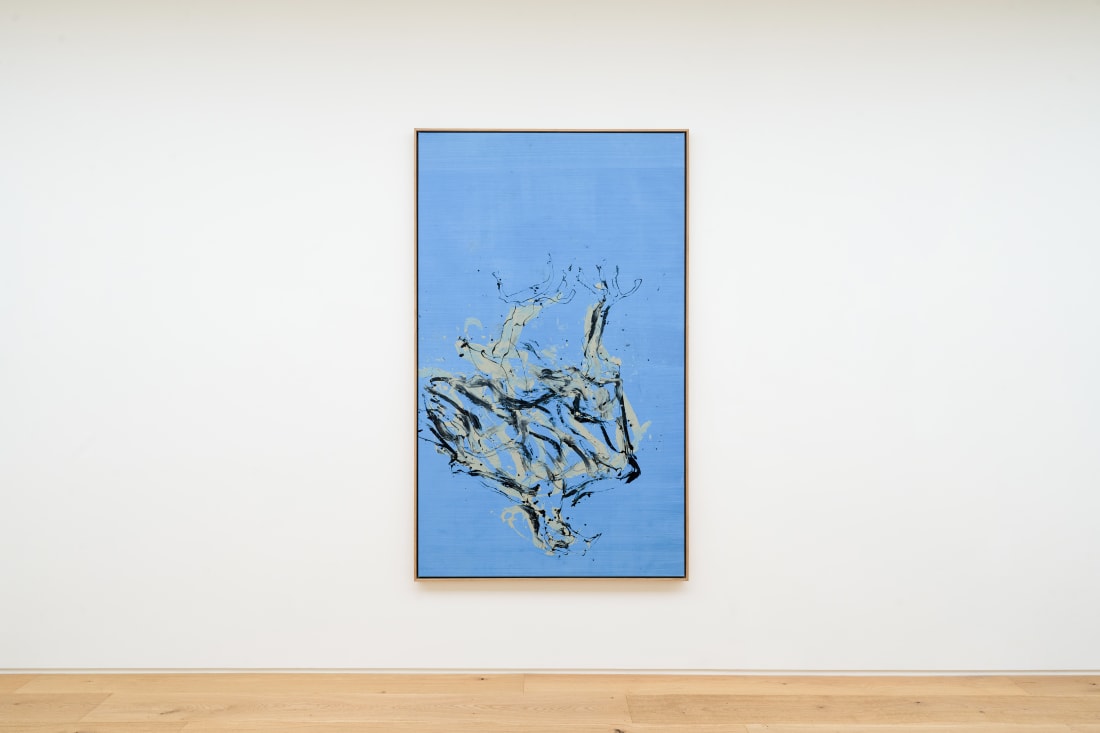Overview
The exhibition adler barfuß at Thaddaeus Ropac Seoul presents works from a new series of paintings and ink drawings featuring eagles, a motif that has resurfaced in Georg Baselitz’s oeuvre throughout his life. Since the 1960s, Baselitz has consistently renewed his practice through innovative formal developments, often responding to art history and his own extensive oeuvre.
After the artist’s first-ever solo exhibition in Korea at the National Museum of Contemporary Art, Korea in 2007, Baselitz’s works were shown at Thaddaeus Ropac Seoul in 2021 for the gallery’s inaugural exhibition. This exhibition of new works is now the third solo presentation of the artist’s work in Korea.
Depicted in tactile, multicoloured impasto, the works feature eagles rendered in gestural strokes, larger than life, hovering in an undefined space. Seemingly weightless, the eagles seem to float against backgrounds of varying shades of blue, evoking the tones found in the portraits of Lucas Cranach the Elder or in Picasso’s surrealist beach paintings of the late 1920s and 1930s.
The exhibition adler barfuß at Thaddaeus Ropac Seoul presents works from a new series of paintings and ink drawings featuring eagles, a motif that has resurfaced in Georg Baselitz’s oeuvre throughout his life. Since the 1960s, Baselitz has consistently renewed his practice through innovative formal developments, often responding to art history and his own extensive oeuvre.
After the artist’s first-ever solo exhibition in Korea at the National Museum of Contemporary Art, Korea in 2007, Baselitz’s works were shown at Thaddaeus Ropac Seoul in 2021 for the gallery’s inaugural exhibition. This exhibition of new works is now the third solo presentation of the artist’s work in Korea.
Depicted in tactile, multicoloured impasto, the works feature eagles rendered in gestural strokes, larger than life, hovering in an undefined space. Seemingly weightless, the eagles seem to float against backgrounds of varying shades of blue, evoking the tones found in the portraits of Lucas Cranach the Elder or in Picasso’s surrealist beach paintings of the late 1920s and 1930s.
Perched in front of this blue, delineated in two to three colours, always including black, the eagles convey a sense of the vigour with which they were painted. Baselitz uses spatulas rather than paint brushes, producing marks that recall middle and late period Rembrandt and, even more so, pen and ink drawings by Hokusai. ‘In Baselitz’s pictures the eagles are fully awake, as if electrified by painting that is wholly present, as if the bird had only just, in this very moment, materialised on the canvas [...] Filigree and powerful at once: a typical Baselitz paradox.’ writes Andreas Zimmermann, curator of the celebrated exhibition Georg Baselitz: Naked Masters (2023) at the Kunsthistorisches Museum, Vienna, in the catalogue accompanying this exhibition.
I found the excuse for painting eagles in my own past, my early past, by digging out children’s drawings and finding the eagle watercolour. — Georg Baselitz, 2024
In several of the pen and ink drawings, the birds are portrayed against a backdrop of mountain ranges, directly referencing the artist’s first exploration of this subject. At the age of fifteen, Baselitz painted one of his earliest works, which also depicted two eagles flying over mountains. As Andreas Zimmermann observes, ‘the importance Baselitz attaches to this early work, done when he was still a schoolboy, is evident from the fact that over the decades he has repeatedly returned to it.’ Primarily realised in a palette of vivid reds, these works on paper engage in a dialogue between ink-drawn lines, washes of colour and undefined space.
While Baselitz’s painting technique has been subject to constant transformation, his thematic vocabulary revolves around a number of key subjects that run through his oeuvre like a golden thread and notably include portraits of Elke. The return to the highly symbolic motif of the eagle in this most recent series integrates a wide range of historical and art-historical references into his work, including Rembrandt’s iconic depiction of Ganymede, in the collection of the Gemäldegalerie Alte Meister in Dresden, which Baselitz was familiar with from a young age. ‘The eagle embodies qualities that have fuelled the human imagination for thousands of years,’ writes Zimmermann, and its great significance as a heraldic symbol in German history further plays into the backdrop of Baselitz’s repeated examination of this subject.
Baselitz’s works can almost always be tied to his experiences and impressions during his childhood in Dresden and the ensuing formative years he spent in Berlin. By revisiting the motifs of his past, Baselitz offers a reflection on the significance of painting itself. Asked about this self-referentiality, he stated: ‘I kept sinking into myself, and everything I do is being pulled out of myself.’
The exhibition is accompanied by a fully illustrated catalogue.

























































































































































































